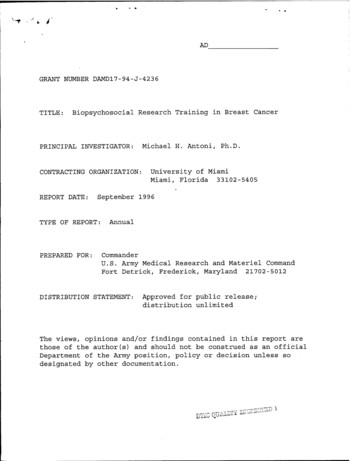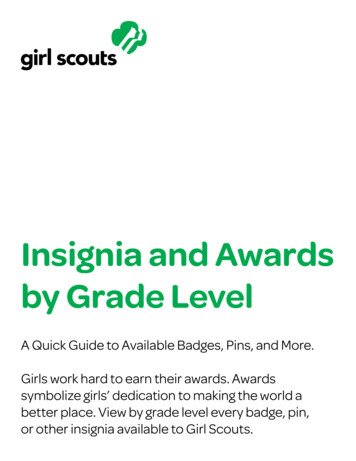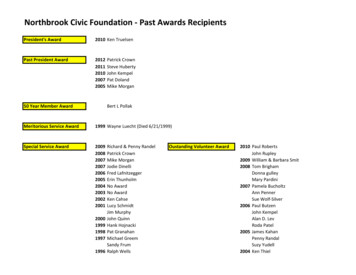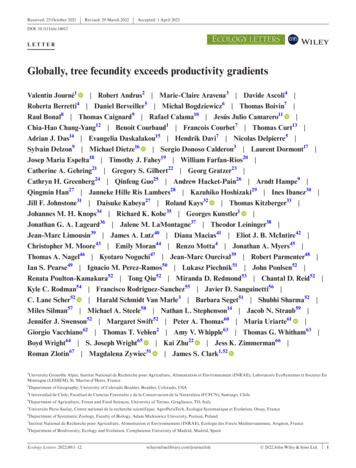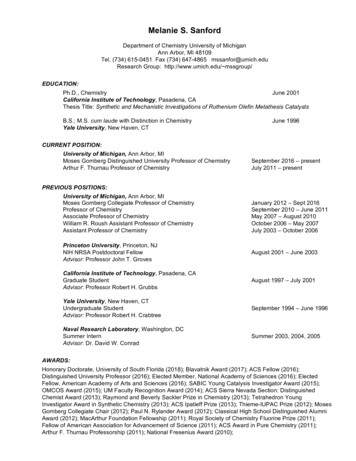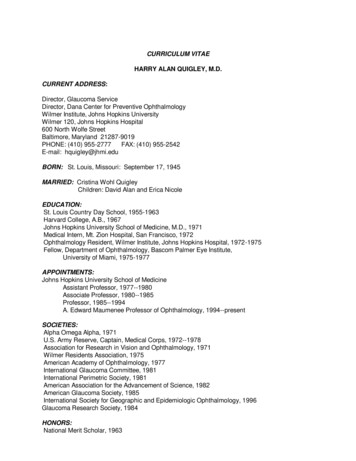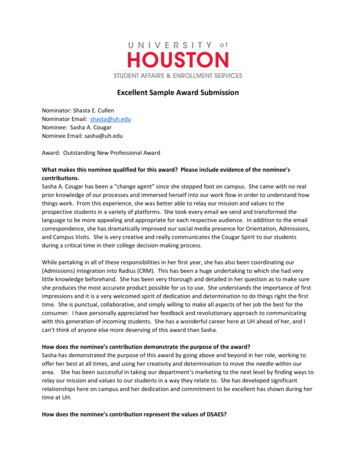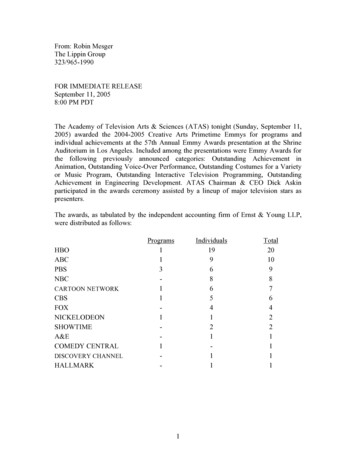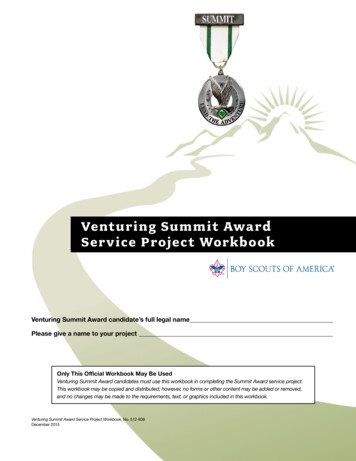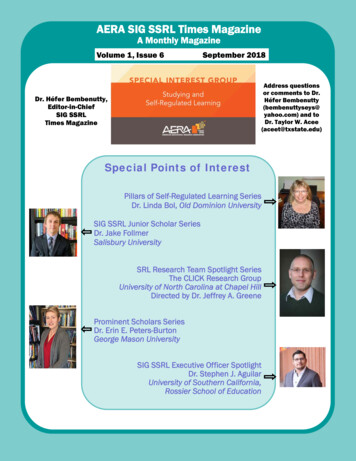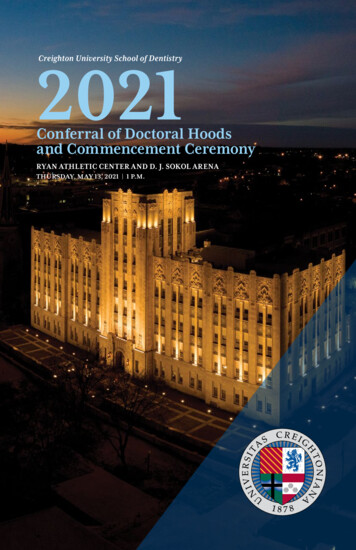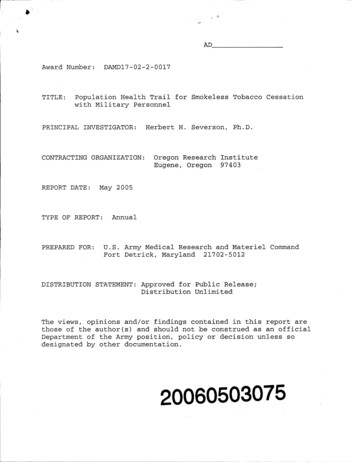
Transcription
LADDAMD17-02-2-0017Award Number:TITLE:Population Health Trail for Smokeless Tobacco Cessationwith Military PersonnelPRINCIPAL INVESTIGATOR:Herbert H.CONTRACTING ORGANIZATION:REPORT DATE:Ph.D.Oregon Research Institute97403Eugene, OregonMay 2005TYPE OF REPORT:PREPARED FOR:Severson,AnnualU.S. Army Medical Research and Materiel Command21702-5012Fort Detrick, MarylandDISTRIBUTION STATEMENT:Approved for Public Release;Distribution UnlimitedThe views, opinions and/or findings contained in this report arethose of the author(s) and should not be construed as an officialDepartment of the Army position, policy or decision unless sodesignated by other documentation.20060503075
Form ApprovedREPORT DOCUMENTATION PAGEOMB No. 074-0188Public reporting burden for this collection of information is estimated to average 1 hour per response, including the time for reviewing instructions, searching existing data sources, gathering and maintainingthe data needed, and completing and reviewing this collection of information. Send comments regarding this burden estimate or any other aspect of this collection of information, including suggestions forreducing this burden to Washington Headquarters Services, Directorate for Information Operations and Reports, 1215 Jefferson Davis Highway, Suite 1204, Arlington, VA 22202-4302, and to the Office ofManagement and Budget, Paperwork Reduction Project (0704-0188), Washington, DC 205031. AGENCY USE ONLY(Leave blank)I2. REPORT DATE3. REPORT TYPE AND DATES COVEREDMay 2005Annual(1 May 2004 -30 Apr 2005)4. TITLE AND SUBTITLE5. FUNDING NUMBERSPopulation Health Trail for Smokeless Tobacco Cessationwith Military PersonnelDAMD17-02-2-00176. AUTHOR(S)Herbert H.Severson,Ph.D.8. PERFORMING ORGANIZATION7. PERFORMING ORGANIZA TION NAME(S) AND ADDRESS(ES)REPORT NUMBEROregon Research Institute97403Eugene, OregonE-Mail:herb@ori.org10. SPONSORING/ MONITORINGAGENCY REPORT NUMBER9. SPONSORING / MONITORINGAGENCY NAME(S) AND ADDRESS(ES)U.S. Army Medical Research and Materiel Command21702-5012Fort Detrick, Maryland11. SUPPLEMENTARY NOTES12b. DISTRIBUTION CODE12a. DISTRIBUTION/AVAILABILITY STATEMENTApproved for Public Release;Distribution Unlimited13. ABSTRACT (Maximum 200 Words)While smoking cessation has received considerable attention within the military, the useof smokeless tobacco (chewing tobacco and snuff) has not been a focus of medical servicesor research. Epidemiological data suggest that while smoking has continued to decline bothin the general population and within the military, the use of smokeless tobacco productsThe primary objective of this research is to develop and evaluate anhas increased.intervention for smokeless tobacco cessation comprised of proactive recruitment, targetedwritten and video materials mailed to the participant, and phone call support. At the endof this third year of the study, several accomplishments have been achieved.for orientation and training at dental clinics at 14Accomplishments include visits6 AF sites were added for enrollment purposes; 5 Armyinstallations:militaryadditionalsites; Camp Pendleton, CA, for Marine enrollment; and 2 Navy clinics in San Diego forA total of 667 participants have now enrolled in the study.enrollment of Navy personnel.Mailed follow-up assessments at three and six months post enrollment were continued, with313 three-month surveys and 233 six-month surveys completed to date.14. SUBJECT TERMS15. NUMBER OF PAGESSmokeless tobacco cessation, military, organizational support,population-based, tobacco cessationrandomized trial,3716. PRICE CODE17. SECURITY CLASSIFICA TIONOF REPORTUnclassifiedNSN 7540-01-280-550018. SECURITY CLASSIFICA TIONOF THIS PAGEUnclassified19. SECURITY CLASSIFICA TIONOFABSTRACTUnclassified20. LIMITATION OF ABSTRACTUnlimitedStandard Form 298 (Rev. 2-89)Prescribed by ANSI Std. Z39-18298-102
Table of ContentsCover .1SF 298 . 2Introduction . 4Body . 4Key Research Accomplishments . 7Reportable Outcomes . 7Conclusions .8References . N/AAppendices .310
INTRODUCTIONWhile smoking cessation has received considerable attention within the military, the use of smokelesstobacco (chewing tobacco and snuff) has not been a focus of medical services or research.Epidemiological data suggest that while smoking has continued to decline both in the generalpopulation and within the military, the use of smokeless tobacco products has increased. The primaryobjective of this research is to develop and evaluate an intervention for smokeless tobacco cessationcomprised of proactive recruitment, targeted written and video materials mailed to the participant,and phone call support. The primary hypothesis to be tested is that participants randomized toreceive the intervention will quit their tobacco use at a significantly higher rate than participantsreceiving usual care. Active duty U.S. Armed Forces personnel stationed at military locations thatare identified as current ST users when completing their annual preventive oral health assessmentwill be recruited to participate in a randomized two-group design that compares a brief contactintervention with the usual preventive health care. Follow up assessments by mail at 3- and 6-monthsafter randomization will assess the impact of the program.BODYIn the third year of our grant, we requested and received approval from the IRB at Brooke ArmyMedical Center (BAMC), TX, to enroll participants at three Army sites in the Great Plains MedicalRegion: Ft Leavenworth, KS, Ft Polk, LA, and Ft Sill, OK. In addition, we requested and receivedapproval from the Walter Reed Army Medical Center to enroll participants at two additional Armysites in the North Atlantic Medical Region: Ft Drum, NY in Year-02, and Ft Knox, KY, in Year-03.Approval for our protocol was previously granted (May 11, 2004) by the Naval Hospital, which is theIRB of record for the Naval Dental Center Southwest and Camp Pendleton in San Diego.Recruitment has been underway at these Army, Navy, and Marine sites in the third year of our grant.In addition, five additional Air Force sites were approved for participation by the Wilford HallMedical Center (WHMC) IRB: Robins AFB, GA, Mt Home AFB, ID, Little Rock AFB, AR,Langley AFB, VA, and Nellis AFB, NV. A sixth AFB, Eglin AFB, FL, was approved forparticipation by the Eglin Medical Center IRB. In total our study is involved with recruitingparticipants at 21 military bases as listed in the table below.To optimize enrollment of volunteers into the trial, we visited each new site and conductedorientation and training with the dental clinic providers and staff. It is the providers who are the oneswho first approach potential participants with the opportunity to enroll in the study. Across all siteswhere we are presently recruiting, we have enrolled 667 participants to date. For the 334 participantsassigned to the Treatment Group, we have completed approximately 761 telephone counseling calls.We are also in the process of collecting three and six-month follow-up assessments via mail. We usetelephone surveys for participants not responding to mailed surveys. To date we have collected 313three-month follow-up assessments and 233 six-month assessments. We have collected three-monthfollow-up data from approximately 66% of participants who have reached the three-month follow-upassessment and approximately 67% from participants who have reached the six-month follow-upassessment.Recruitment of Intervention SitesListed below are the Air Force, Army, Navy, and Marine sites that are currently participating in ourstudy. The point of contact (POC) is the person located at the dental clinic who will oversee theproject at that site.4
POC. BaseAir ForceArmyNavyUSMCStart DateLackland AFB, TX (3 clinics)Randolph AFB, TXWright Patterson AFB, OHLt Col (Dr.) Alan PetersonCol Carlos EsquivelLt Col (Dr.) Jeff Cigrang09/02/200309/08/200309/02/2003Dyess AFB, TXLt Col Randall Griffin11/17/2003Sheppard AFB, TXBrooks City Base, TXLaughlin AFB, TXCapt (Dr.) Bruce AbeMaj Jacob PalmaCapt (Dr.) Mark Halverson11/18/200301/07/200401/13/2004Robins AFB, GAMt Home AFB, IDLittle Rock AFB, ARLangley AFB, VANellis AFB, NVEglin AFB, FLMaj Elizabeth TandyCapt. William QuinnLt Col Robert AbbottCol Robert SabatiniLt Col Jeff ThompsonCol Mike 28/200411/09/2004Ft. Sam Houston, TXFt. Sill, OKCOL Ronald LambertLTC Charles Sabadell09/18/200307/15/2004Ft. Polk, LAFt. Leavenworth, KSFt. Drum, NYFt. Knox, KYCOL Thomas MacKenzieLTC Robert WindomCOL Robert RockCOL Stephen Rouse08/16/200408/03/200409/04/200404/05/2005North Island Dental ClinicCamp Pendleton, clinic 13CAPT Richard A. JoralmonCAPT Wayne Osborne06/17/200406/18/2005Air ForceAll of the Air Force sites listed above honored the Wilford Hall Medical Center (WHMC) IRBapproval of our protocol, with the exception of Wright-Patterson AFB, OH, Eglin AFB, FL, andBrooks City Base, TX, which have their own IRBs. Our protocol had been previously approved bythe Wright-Patterson Medical Center IRB in 2003 and by the Brooks City IRB in Jan 04: Ourprotocol was expeditiously cleared through both the Eglin IRB later in 2004 to allow us to beginrecruiting participants there in November 2004.ArmyFour of the participating Army sites are in the Great Plains Medical Region and thus fall under theauthority of the BAMC IRB. They include: Ft Sam Houston, TX; Ft Sill, OK; Ft Polk, LA; and FtLeavenworth, KS. The BAMC IRB approved our protocol for those sites in expeditious fashion,allowing for recruitment to continue (at Ft Sam Houston) and to begin at Ft Sill, Ft Polk, and FtLeavenworth in the Jul-Aug 2004 timeframe. The BAMC IRB allowed us to use the short, 4-pageenrollment packet that had been approved for the Air Force by WHMC. As a consequence,enrollment at sites in the Great Plains Medical Region has been very good, on a par with AF siteswhere the shorter enrollment packet is being used.The remaining Army sites, Ft Drum, NY, and Ft Knox, KY, are in the North Atlantic Medical Regionand thus fall under the authority of the Walter Reed Army Medical Center IRB. For these two armysites, we were required to use a lengthier 10-page enrollment packet. The longer enrollment packethas adversely impacted enrollment at Ft Drum, NY, according to POCs at that site, COL Robert Rockand PI/A Jane Bowers. As of yet we do not know the impact of the longer enrollment form at Ft5
Knox, KY, as we just began recruitment there in April 05.North Atlantic Medical Region Army SitesThe process of gaining IRB approval from the Walter Reed Army Medical Center IRB (WRAMC)for enrollment at Ft Drum was quite protracted, lasting at least 12-months. Once the approval wasobtained, we were required to use a much longer enrollment packet, i.e., 10 pages long vs. the 4-pageenrollment packet approved for AFBs (under the WHMC, Wright-Patterson, and Eglin IRBs) andArmy sites in the Great Plains Region (BAMC IRB). As a consequence, enrollment at Ft Drum hasbeen adversely impacted by the longer enrollment forms. The impact of the consent form onenrollment is discussed further in the Reportable Outcomes Section.Navy and MarinesThe process of gaining IRB approval from the Navy Hospital IRB for enrollment at identified Navyand Marine bases was quite protracted as well, lasting 9-months. Again we were required to use alengthy enrollment packet, i.e., 8 pages long. Recruitment at these sites has also been negativelyimpacted by the longer enrollment forms. See Reportable Outcomes Section for further discussion.Processing Amendments to the Original Study ProtocolIt has been necessary in the third year of the study to submit several protocol amendments to thegoverning IRBs. The principal amendments concerned the posting of flyers to advertise the study ateach site, changing the second follow-up assessment from 12 months post enrollment to 6 months,and offering cessation materials to Control Group subjects at the time of the 6-month follow-upassessment. We were able to get expeditious approval of amendments from the WHMC, WrightPatterson, Eglin, and BAMC IRBs for these amendments. However, by contrast, approval by theWRAMC IRB was prolonged and frustrating to investigators because of a lack of responsiveness byWRAMC IRB staff and the seemingly continuous changing of POCs at Walter Reed for processingour amendment requests.Utilization of Telephone Counseling Guidelines based on Principles of MotivationalInterviewingA crucial part of the intervention in this study is the phone call support given by project phonecounselors. We have continued to implement, refine, and monitor the quality of telephone counselingcalls that incorporate Motivational Interviewing (MI) techniques to reinforce participants' ownmotivation for quitting smokeless tobacco. We continue to conduct regular supervision sessions withphone counselors to ensure quality and consistency of counseling calls across counselors and acrosstime.Utilization of Data Entry/Management SystemIn this study, data are collected at various points in time at both research sites - Oregon ResearchInstitute (ORI) in Eugene, OR, and Wilford Hall Medical Center (WHMC) in San Antonio, TX. Wecollect baseline tobacco use data along with consent information from participants at the variousdental clinics at the time of participant enrollment. Those data are forwarded by the clinics to ORIfor data entry. We collect various data points from participants in the Treatment Group at the time oftelephone counseling conducted out of the WHMC research site. We conduct follow-up surveyassessments by mail with all participants, in both Treatment and Control Groups, at 3- and 6-monthspost enrollment and those assessments are both sent and processed at ORI by project staff. If the6
participant does not respond to requests to complete the mailed survey, we call them to conduct atelephone survey, using the same questions. These calls are primarily made by WHMC project staff.In order to centralize and effectively manage the myriad data collected at both sites, we havecontinued in Year-03 to utilize, and in some cases refine, the Electronic Data Management Systemdeveloped in Year-02. The system is accessible by research staff at WHMC through a virtual privatenetwork (VPN) that completely protects participant confidentiality and allows WHMC research staffin Texas to accomplish data entry and updates as needed. In addition to being a repository forcollected data, the system also serves a scheduling function. It schedules the dates for the threecounseling calls to Treatment participants, as well as dates for follow-up assessments. The evolvingdatabase will provide the basis for all data analysis procedures to be conducted at the conclusion ofthe data collection phase.The database development, expansion, and shared input by staff at WHMC and ORI are key activitiesin the project. The data entry is all done at ORI where the enrollment data and all follow-up data arestored in secure files by participant number. However after randomization of the participant iscompleted, any participant assigned to the Treatment condition will be contacted by phone. Allphone contacts are done by phone counselors at WHMC, and the information they collect is inputinto the database for that participant. The Virtual Private Network connection, which was developedand implemented in Year-02, allows the phone counselor to enter key data for the participant into thedatabase. The counselor can also access the database prior to the call to determine the degree of theparticipant's readiness to quit, amount of smokeless tobacco (ST) used, and other relevantinformation to use in their motivational interview phone calls. This same system is used in thescheduling and tracking of the follow-up assessments at 3- and 6-months.KEY RESEARCH ACCOMPLISHMENTS IN YEAR 03"* Coordinated expanded recruitment to 14 additional sites: six Air Force Bases, five Armyinstallations, one Navy clinic, and one Marine clinic."* Initiated formal enrollment of participants at 14 additional military sites"* Processed protocol amendments through all governing IRBs, including WHMC, WrightPatterson Air Force Medical Center, Eglin Air Force Medical Center, Brooke Army MedicalCenter, Walter Reed Army Medical Center, and the Naval Hospital in San Diego for theCamp Pendleton Marine Base Clinic 13, and the North Island Naval Base Clinic."* We are currently requesting approval from the Naval Medical Center in San Diego for addingthe 3 2 nd Street Clinic in San Diego."* In Year 03 we have enrolled 539 additional participants across all participating sites; wecollected 271 three- month follow-up assessments and 231 six- month assessments. Therewere 661 Counseling Calls made in Year 03."* Continued to utilize and refine an electronic database accessible to project staff at both theORI and WHMC research sites for data entry and update."* Developed and implemented an email prompting system to aid in the prompt completion andreturn of 3- and 6-month mailed assessments by participants in both conditions.REPORTABLE OUTCOMESWe are in the process of collecting 3-month follow-up outcome measures. No follow-up reportableoutcome evaluations have been conducted to date.7
CONCLUSIONSWe are still in the enrollment phase of our study and we have no conclusions to report at this time.We have experienced significant delays in our project due to difficulties in the IRB review processand the project is 6 to 9 months behind schedule at this time. There are several points to make on theIRB process. First, the lack of coordination and cooperation between IRB's of the different branchesof the service has resulted in both delays and frustration. For example, the review by the WRAMCIRB took 6 months to complete and required significant changes in both the Consent and HIPPAforms to nmeet their requirements. It should be noted that the protocol had already been approved bythe IRBs at Brooke Army Medical Center ant Ft Detrick. Even after the WRAMC review wascompleted, the final approval was withheld for some time because our materials and WRAMCapproval had to first be forwarded to the Medical Research and Materiel Command at Fort Detrickfor another review. The review of the approval done at WRAMC was delayed because even anexpedited review of the approved protocol required a staff review and memo to the supervisor at FortDetrick. This resulted in an additional delay of about 8 weeks. Overall, it took about 10 months toobtain WRAMC IRB approval for a study that had already been approved by Wilford Hall MedicalCenter, Brooke Army Medical Center, the Oregon Research Institute, and Ft Detrick. Additionally,the consent form for enrollment was lengthened by the WRAMC IRB from 1 to 6 pages. As areminder, this is a minimal-risk study to help military members quit their use of tobacco.We also experienced a similar delay in the review by the Navy IRB. The Navy IRB had additionalunique requirements for their process and the completion and review of our protocol by the NavalHospital IRB in San Diego took over 6 months. It has been very frustrating to manage a projectwhen we are confronted by numerous obstacles and delays due to numerous IRB reviews. The lackof coordination and cooperation between IRB's of the different branches of the service is a majorimpediment to conducting research at multiple sites. It is particularly frustrating to us, since thisproject is of such minimal risk as to be viewed as exempt by some IRB's. We are simply trying toevaluate whether mailed educational materials and phone call support to active dtay militarypersonnel can aid in their quitting their use of snuff or chewing tobacco. Unfortunately some IRB'shave treated this protocol the same way that one might consider an experimental drug trial. In ouropinion there is a lack of flexibility among IRB committees to view a protocol as minimal risk andconduct a population study such as we proposed. Both the Army IRB at WRAMC and the Navy IRBhad extensive additional text that needed to be added to the Consent and HIPPA forms and this madethe enrollment of participants in the study much more difficult than necessary at sites for which theyare the governing authority. The very lengthy consent form required by these IRBs has had asignificant negative impact on our ability to adequately recruit participants into the study. As anexample of this contract the table below compares the enrollment for bases using different consentprocedures. In all cases, the longer consent form has proved to be a significant impediment toparticipation by military personnel.During the first 9 months of recruitment:Short-formSiteFt Sam Houston, TXFt Leavenworth, KSFt Sill, OKLong-form# ofEnrollees145450# ofPotential STusers on Site1,9067541,906SiteFt Drum, NYCamp Pendleton, CANorth Island Clinic, CA8# ofEnrollees595# ofPotential STusers on Site1,5594,153754
We hope that there is some administrative review of the IRB review process and that procedures areput in place that could provide more timely and coordinated review of protoco Is that involve minimalrisk. We expect to continue enrollment of participants until at least August 2005 in order tomaximize our enrollment of study participants and complete our follow-up assessments within thefunding period for the project.Revised TimelineUpdated timeline - Years 02-04J IJ IAIS10N IDIjF IMYear 04 (May 2005 - April 2006)Year 03 (May 2004 - April 2005)Year 02 (May 2003 - April 2004)MMIAIS10IJ IJ IAN IDIJFMAM IJ IJ IAISO1N IDIJFM IA NVfOSARFAMAMDAFORC FBASISS33 WNT-14AS qANDAIR FORCE E.ASSESSMENTSAPRMYANDAIRFORCE6MON-MMNf kE BAS-ES,EIIMWTS -NAW ANDVI. . . . . . . FRPRODUCTIONDISSF1,1NATRONWe will be requesting a no-cost extension to our project to complete data analysis and final reportsfor the project. The timeline below shows our revised schedule and extended enrollment period toAugust 2005.
APPENDICESEnrollment PacketsA. Oregon Research Institute, Eugene OR, Wilford Hall Medical Center, TX, Wright-PattersonAFB, OH, Eglin AFB, FL, and Brooks City Base, TXB. Water Reed Army Medical CenterC. Naval Medical Center San Diego, CA10
APPENDICE AEnrollment FormsIRB approved enrollment packet (4-pages) used by:-Oregon Research Institute;Wilford Hall Medical Center;Wright-Patterson AFB, OHEglin AFB, FL; andBrooks City Base, TX1. Consent Form (1-page)2. HIPAA (1-page)3.Survey (2-Pages)
o clinic 14 )Statement of Informed Consent: Smokeless Tobacco Use in Military PersonnelThis clinic istaking part ina smokeless tobacco research study. Ifyou chew tobacco or use snuff, we would like you to participate inthis study. We would like to get as close as possible to 100% of smokeless tobacco users to participate. The purpose of this study istoassess the effectiveness of a brief intervention on smokeless tobacco cessation.Your participation involves the following:1)Filling out the attached survey. You do not need to be ready to quit smokeless tobacco to participate. All information collected inthis study will be kept confidential. Only research staff will have access to your information. All data will be stored by Oregon ResearchInstitute, and this information will not be available to your dentist, other health care providers, or to anyone inthe military.2)Willingness to be contacted by phone at home or work and be offered a smokeless tobacco cessation program. Ifyou agree toparticipate, you will be randomly assigned (like the toss of a coin) to the treatment group or the control group. Ifyou are assigned to thetreatment group, we will call you to discuss your tobacco use and offer you a cessation program that would help you quit using smokelesstobacco on your own at home. Ifyou are assigned to the control group, you will not receive any phone calls or the cessation program. Byagreeing to participate inthe study you are not obligated to make a quit attempt even ifyou are assigned to the treatment group.3)You will receive two more surveys by mail similar to the one attached, the first in3 months and the second in6 months.Risks The risks involved inparticipating inthis study may include:1)Loss of confidentiality. We will be getting personal information from you. Your social security number will be used ifneeded to locateyou for follow-up surveys and to document your phone conversations with counselors ifyou are assigned to the treatment group. There isalways the slight possibility that someone who isnot authorized might see the personal information that is requested from you. However, itis extremely unlikely that this will occur, and we will take every precaution to assure that your data remain anonymous.2) Discomfort indiscussing your use of tobacco. You may be unaccustomed to talking with someone about your tobacco use. However,our counselors have been extensively trained inthis area and will be helpful, courteous, and respectful of your needs.3)Withdrawal Symptoms. Ifyou quit using smokeless tobacco, you may experience withdrawal symptoms from nicotine cravings such ashunger, anxiety, restlessness, or sleep disturbance. These symptoms are common for persons quitting their addiction to tobacco products.Our counselors have been extensively trained inthis area and will be helpful, courteous, and respectful of your needs.Benefits The benefits of participating inthis study are:1)You could receive a free smokeless tobacco quitting program that may enable you to quit without attending classes or medicalappointments. Quitting tobacco may be the most important lifestyle change you can make to improve your health.2)The information you give us may help other military personnel inthe future.? YES, Iam interested in participating in this study. (You do not need to be ready to quit to participate.)By signing below Igive my consent for the information I provide on the attached survey to be used by scientists at Oregon ResearchInstitute (Eugene, Oregon). Iunderstand that completing this survey isvoluntary, I may choose to skip any question, and that thisinformation will be kept confidential.I also give my consent to being contacted inthe future, possibly offered a smokeless tobacco cessation program, and being sent follow-upsurveys inthe mail.Printed name/with rankSignatureDateSocial Security Number (Optional)Home phone: (D)Home address:[I prefer daytimen prefer after 1700(Street, City, State and Zip Code)Email address:LI best time is morning - later0 best time isafter 1600Work phone: (. )Put an *next to the number where you prefer to be contacted? No, Iam not interested in participating in this study. AGE years old SEX: ? Male ? Female
((clinic 18&HIPAA AUTHORIZATION TO USE AND DISCLOSEINDIVIDUAL HEALTH INFORMATION FOR RESEARCH PURPOSESWhat is an authorization?Federal privacy regulations provide safeguards for privacy, security, and authorized access to your personal healthinformation. The Federal Health Insurance & Portability Act (HIPAA) protects the privacy of your personal healthinformation that [INSERT Dental Clinic NAME HERE] and Oregon Research Institute collect in the course of thisresearch study. The only health information that we will access is what you provide in the attachedquestionnaire. We WILL NOT obtain any information from your dental or medical records. Healthinformation that identifies you may not be used or disclosed to others for research purposes unless you give writtenpermission in advance.1. Authorization. As a research participant, you authorize Dr. Herbert Severson and Lt Col. Alan Peterson and theirresearch staff to use and disclose your individual health information provided in the attached questionnaire for thepurpose of conducting the research project entitled "Population Health Trial for Smokeless Tobacco Cessation with MilitaryPersonnel".2. Information to be Used or Disclosed. Your individual health information that may be used or disclosed to conductthe study includes: tobacco use history and demographic information such as age, gender, race, rank, education level,marital status, height, and weight.3. Parties Authorized to Disclose Information. The researcher and the researcher's staff may obtain your individualhealth information from the attached questionnaire.4. Parties Who May Receive or Use Information. Your individual health information disclosed in the attachedquestionnaire and information disclosed by you or discovered about you during the course of the research may bedisclosed to (1) the study investigators (Dr. Herbert H. Severson and Lt Col Alan Peterson), (2) the sponsor of thisresearch (the Department of Defense U.S. Army Medical Research and Materiel Command), and (3) the InstitutionalReview Boards that review this research to make sure that it is ethical (Oregon Research Institute, Wilford Hall MedicalCenter, and Wright-Patterson Medical Center).5. Right to Refuse to Sign this Authorization. You understand that you do not have to sign this Authorization.However, if you do not sign this authorization, you will not be allowed to participate in this research study. Your decisionnot to sign this Authorization will not affect any other treatm
orientation and training with the dental clinic providers and staff. It is the providers who are the ones . Air Force Lackland AFB, TX (3 clinics) Lt Col (Dr.) Alan Peterson 09/02/2003 Randolph AFB, TX Col Carlos Esquivel 09/08/2003 Wright Patterson AFB, OH Lt Col (Dr.) Jeff Cigrang 09/02/2003 Dyess AFB, TX Lt Col Randall Griffin 11/17/2003
